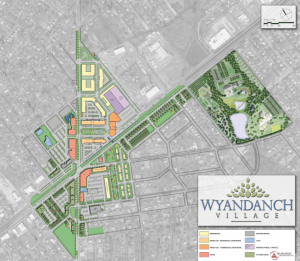Wyandanch Rising brought together hundreds of homeowners, businesses, property owners, civic groups, clergy, planners, architects, and government officials to develop the vision for a pedestrian-friendly community where people can live in multi-family, multi-story buildings within close proximity to goods, services, and activities not needing cars for everyday transportation. The Long Island Regional Planning Council designated Wyandanch Rising as a Project of Regional Significance.
 Like other communities that are benefitting from elements of smart growth, Wyandanch has been economically distressed. In the early 2000s, community leaders banded together to develop a vision for a vibrant city-style, high-density downtown where none had existed before. The project has become a $500 million overhaul centered around the idea of Transit-Oriented Development, which provides the opportunity to increase transportation choices and access, enhances mobility for all community members, and creates a compact mixed-use neighborhood.
Like other communities that are benefitting from elements of smart growth, Wyandanch has been economically distressed. In the early 2000s, community leaders banded together to develop a vision for a vibrant city-style, high-density downtown where none had existed before. The project has become a $500 million overhaul centered around the idea of Transit-Oriented Development, which provides the opportunity to increase transportation choices and access, enhances mobility for all community members, and creates a compact mixed-use neighborhood.
The plan for Wyandanch includes multi-story mixed-use buildings that will feature apartments in the upper stories and retail space below. Included are apartments, from studios to three bedrooms, with a large number reserved for lower income tenants. Ground-floor commercial spaces will be no larger than 5,000 square feet each to discourage big-box stores. Plans also include a public park which can host concerts in the summer and an ice rink in the winter, a multi-story office building, whose 25,000-square-foot ground-level berth is being considered for a grocery store and improvements to the Wyandanch LIRR station.
To date, 177 residential units – including 123 qualifying as affordable housing – have been completed, along with some 35,000 square feet of ground-level retail space. In addition, the Metropolitan Transportation Authority has built a parking garage in the area.
 The November 2, 2017 meeting of the LIRPC highlighted the presentation “Wyandanch Rising: A Community’s Transformation” and included presentations by Russell Albanese, Chairman, The Albanese Organization; Tony Martinez, Deputy Supervisor, Councilman, Town of Babylon; Theresa Ward, Commissioner of Economic Development and Planning, Suffolk County; David Erickson, Hudson River HealthCare; Gwen O’Shea, President & CEO, CDCLI, and Peter Goldsmith, President, LISTnet.
The November 2, 2017 meeting of the LIRPC highlighted the presentation “Wyandanch Rising: A Community’s Transformation” and included presentations by Russell Albanese, Chairman, The Albanese Organization; Tony Martinez, Deputy Supervisor, Councilman, Town of Babylon; Theresa Ward, Commissioner of Economic Development and Planning, Suffolk County; David Erickson, Hudson River HealthCare; Gwen O’Shea, President & CEO, CDCLI, and Peter Goldsmith, President, LISTnet.
Related Content


